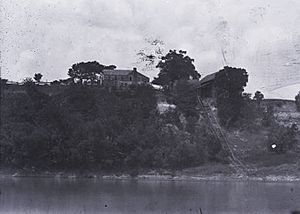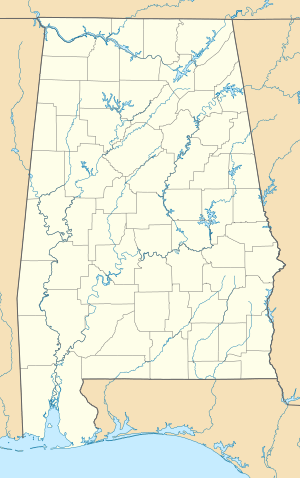Prairie Bluff, Alabama facts for kids
Quick facts for kids
Prairie Bluff, Alabama
|
|
|---|---|

Prairie Bluff, taken from the Alabama River in 1894. Some buildings and the cotton slide were still present at this time.
|
|
| Country | United States |
| State | Alabama |
| County | Wilcox |
| Elevation | 141 ft (43 m) |
| Time zone | UTC-6 (Central (CST)) |
| • Summer (DST) | UTC-5 (CDT) |
| Area code(s) | 334 |
Prairie Bluff, also known as Dale or Daletown, is a ghost town in Wilcox County, Alabama. A ghost town is a place where most people have left, leaving behind empty buildings.
Contents
The Story of Prairie Bluff
Prairie Bluff first appeared on maps in 1819. This was the same year Alabama became a state in the United States. Sometimes, it was mistakenly called Prairie Blue on early maps.
For many years, the town was also known as Dale or Daletown. By the mid-1850s, only the name Prairie Bluff was used. The town disappeared from maps completely around 1900.
How Prairie Bluff Grew
Prairie Bluff was located on an important early road. This road connected Cahaba, Alabama's first state capital, and St. Stephens, the territorial capital.
The town was built on a cliff overlooking the Alabama River. As trade on the river grew, so did Prairie Bluff. A large slide was used to move bales of cotton from the top of the cliff to paddle steamers below.
River travel could be dangerous. For example, the steamboat Pittsburg sank near Prairie Bluff in May 1828. Another steamboat, the Jewess, sank there in October 1841.
Why Prairie Bluff Disappeared
Prairie Bluff was at its busiest around 1861. However, its importance quickly faded after the American Civil War. New railroads were built, which made river trade less important.
In 1963, parts of the old town site were covered by water. This happened when the Millers Ferry Lock and Dam was built nearby. This created the William "Bill" Dannelly Reservoir.
What's Left Today?
Today, the only physical part of Prairie Bluff that remains is its cemetery. You can find graves there dating from the 1830s to the 1860s. It's a quiet reminder of a town that once thrived.
Where is Prairie Bluff?
The site of Prairie Bluff is located at 32°08′04″N 87°24′13″W / 32.1343111°N 87.4036071°W. It sits at an elevation of about 141 feet (43 meters).
The area is known for a special type of rock called the Prairie Bluff Chalk Formation. This geological formation was actually named after the town itself.
Famous People from Prairie Bluff
Some notable people were born near or had connections to Prairie Bluff:
- William H. Gaston: He was a landowner in Dallas and helped start the first banking house there.
- William Q. Atwood: He became a very successful lumber businessman in Saginaw, Michigan.
- Mrs. I. Lowenberg: She was an author, a leader in women's clubs, and worked for social change.



